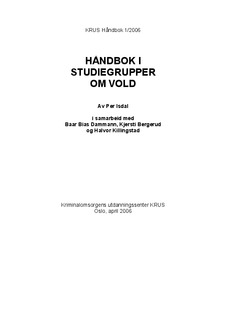| dc.description.abstract | The first part of this manual gives a description of form, contents, objective, method and theoretical superstructure. The second part gives a concrete description of the contents of the different group meetings.
The manual presupposes familiarity with the books
Meningen med volden (Isdal 2000) and Håndbok i samtalegrupper for voldsdømte (Isdal & Dammann 2003).
The ATV-model of treatment has four leading principals, which are realized in the 13 topics of the study-groups:
1. Focus on violence
2. Focus on responsibility
3. Focus on coherence
4. Focus on effect and consequence
The study-groups are a furthering of the conversation-groups – ideally a step II for participants who have already followed a conversation group.
The study-group can give new motivation to those who like and are suited for groups of the ATV-type. The observance of professional secrecy is the same for both groups.
The short version of the study-group constitutes 15-18 group meetings, the long version 30-35 meetings. The size of the group can vary from 3-10 participants - the ideal being 4-5.
The study-group follows a defined plan of progress throughout the 13 topics, which build on each other. For this reason, the groups should be closed.
Conversation against violence is the principal idea behind both the conversation-groups and the study-groups – at ATV we consider ability to express thoughts and feelings in words as the most important alternative to violence. The objective of the study-group is for the participants to gain a larger understanding of violence, both as a
phenomenon of society and in their own lives, through a structured process. Hence, the study-groups does not direct change of behavior, but are instead directed towards conditions we think might have an impact on violent behavior. The study-groups are part of the empowerment tradition, and behind this lies a belief in that everybody can change if they have the knowledge, skills and motivation necessary to make different choices.
The method in use is psycho-educative – awareness through education - and focuses directly on the area of problems, in this case violence (except for violence comprised by the law of sexual crime, although exceptions are made). The approach is based on the view that violence to a large degree is a problem of attitude and awareness.
The study-group is to be lead by two group-leaders, who have a double function: as teachers they are to create a pedagogical process, and as leaders they are responsible for contact with the establishment as well as registration and reporting. The group leaders are to work together as a team. It is also a central point that the group-leaders are able to receive the participant’s stories in a non-judgmental, understanding, warm, listening and supportive manner.
It is a presupposition that the participants master the Norwegian language well, and it is necessary to know that the participants are able to follow the whole process. It is not desirable with participants only partaking a few times, or participants who partake on an irregular basis.
Timing is essential. When a successful therapy with inmates is finished many years in advance of release, the remaining time of the serving might destroy the effect of the treatment. Treatment should ideally continue for a period after release. Choice of room signals how important the establishment considers the study-group to be. The group should meet in a suitable room where the participants can talk undisturbed. It is not recommended to use classrooms. | en_US |
